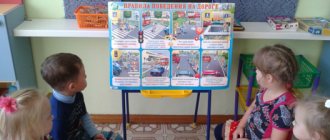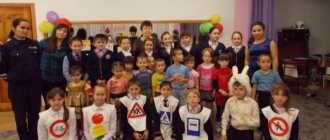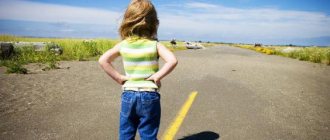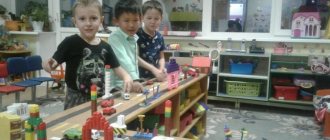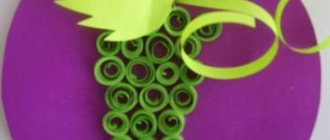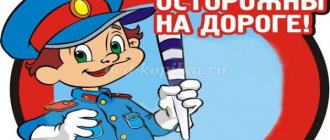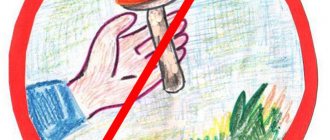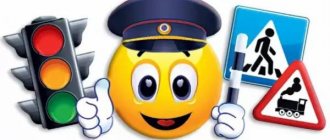Sample texts for certificates for participation (and for winning) in a competition (professional and children's). Designed both for those who took first (and any other) place, and for organizers, ordinary participants, and teams.
All names, surnames, and names of organizations are used solely for convenience of presentation; do not forget to change them to the ones you need.
You will find design guidelines at the end of the page.
Option #1
Administration of the Yaroslavl region
Awards
LLC "Super Project"
Rodionov R.M., Neznaykin O.Sh., Vostrov U.T.
for active participation in the XIII regional annual competition of professional skills of architects of the Yaroslavl region
and the project “Specialized hospital complex for innovative treatment and diagnostics at the address:
Yaroslavl region, Danilovsky district, village of Sereda.
Deputy
Governor of the region
Z. Kh. Khrustalev
2021
Project on traffic rules “Road literacy” in the middle group.
author: Eremeeva Ekaterina Andreevna
Teacher of MBDOU "TsRR - kindergarten No. 15"
Project on traffic rules “Road literacy” in the middle group.
Municipal budgetary preschool educational institution
"Child Development Center - Kindergarten No. 15"
Project on traffic regulations “Road Certificate”
in the middle group.
Educator:
Eremeeva Ekaterina Andreevna
Chernushka, 2022
Project type:
informational, practice-oriented, comprehensive, group, short-term.
Relevance:
Every year hundreds of accidents occur on the roads of our country, in which, unfortunately, children are also involved: they die and are injured. That is why the prevention of road traffic injuries remains a priority for society. And this task requires special attention and an indispensable solution with the general participation of both children and adults, and using the most effective methods.
Often, the culprits of road accidents are children themselves, who play near roads, cross the street in the wrong places, and incorrectly enter and exit vehicles. That is why, from a very early age, it is imperative to familiarize the child with behavior on the streets, roads, in transport, as well as traffic rules.
The relevance of the project is also due to the fact that preschool children do not have a protective psychological reaction to traffic conditions, which is typical for adults. The desire to constantly discover something new and spontaneity often put them in front of real dangers, in particular on the streets. The formation of children's skills of conscious safe behavior on city streets is realized through the active work of all project participants.
Subject of study:
The process of forming the foundations of a safety culture according to traffic rules in educational activities for children of middle preschool age.
Problem:
The problem of compliance with traffic rules has become particularly acute and multifaceted due to the large increase in the number of cars and other vehicles on the roads of our country and the very weak inculcation of a culture of safety and discipline among road users.
In improving and consolidating knowledge, a special role is given to the organization of children’s play activities, in which the spatial orientation of preschoolers and their ability to apply this knowledge in practice are formed.
Objective of the project
– formation and development in children of the necessary skills for safe behavior on the roads.
Project objectives:
Educational:
— introduce children to traffic rules, street structure, road signs;
- form ideas about the purpose of a traffic light and its signals;
- teach children to anticipate a dangerous event, be able to avoid it, if possible, and act if necessary.
Educational:
— develop caution, attentiveness, independence, responsibility and prudence on the road;
— stimulate cognitive activity, promote the development of communication skills.
Speech:
— promote the development of children’s speech, replenish the active and passive vocabulary of children in the process of working on the project;
- develop coherent speech.
Educational:
- develop personal safety skills and a sense of self-preservation.
Research hypothesis:
Positive effectiveness in children of middle preschool age in developing safe behavior skills on the street can be achieved if information on traffic safety, traffic rules, possible situations on the road and options is included in different types of activities (independent, joint, directly educational). avoiding such situations.
Expected results:
—
providing conditions for organizing the activities of preschool educational institutions for the protection and safety of the child’s life;
— strengthening joint cooperation between the preschool educational institution and the traffic police on the prevention of child road traffic injuries;
— development of a short-term plan of work with children of the middle group and their parents as part of familiarizing the child with the rules of the road;
— formation in children of a correct understanding of the importance of traffic rules, their place as a road user, and the development of the skills and abilities necessary for this.
Research methods:
- Direct educational activities:
- Artistic creativity.
- Situational simulation modeling.
- Reading fiction.
- Targeted walks and excursions along the city streets.
- Experimental and search activities.
- Game activities: didactic, role-playing, outdoor games.
- Conducting a quiz on the project topic.
- Analysis of situations, application of acquired theoretical knowledge in practice.
- Thematic dives on the topic of the project.
- Working with parents.
- Use of audio and video materials on traffic rules.
Project stages:
Stage 1
(formulation of the problem):
— pose the problem to the children: “Why is it necessary to know the rules of the road?”;
— determine the project product:
a) creating a city model;
b) knowledge of traffic rules;
c) conducting game training on the topic of the project.
Stage 2
(discussion of the problem, acceptance of tasks):
— convey to children the importance of this problem: “Ignorance of traffic rules can lead to trouble!”;
— select fiction, audio and video materials, prepare visually illustrated material on the topic of the project;
— draw up a long-term work plan for the project;
— study methodological literature: Avdeeva N.N., Sterkina R.B., Knyazeva O.L. “Fundamentals of the safety of preschool children”; Belaya K.Yu. “How to ensure the safety of preschool children”; Dobryakov V.A. "Three traffic lights"; Kiryanov V.N. “Prevention of child road traffic injuries”; Kogan M.S. “Everyone should know the rules of the road”; Rublyak V.E. "Traffic Laws"; Smushkevich E.S., Yakupov A.Ya. “we are walking down the street”; Stepankova E.Ya. “For preschoolers - about the rules of the road” and others;
— hold conversations with children on the topic: “Attention, road signs!”, “How to behave on the street and in transport?”, “What traffic rules do you know?”, “Who controls the road?”;
— replenish the subject-development environment;
- Conduct surveys and testing with parents.
Stage 3
(Project work):
— organize work to solve project problems through:
- Direct educational activities:
— “Always remember road signs”;
— “About the work of the traffic police”;
- “Careful, road!”;
— “Rules for passengers”;
— “Transport on city streets.”
- Artistic creativity:
— drawing: “Dangerous situations on the road”, “Create a new road sign”, “City streets”;
- modeling: “Cheerful traffic light”, “Guard”;
— application: “Road sign”, “Noisy intersection”.
- Situational simulation modeling.
- Reading fiction:
Bedarev O. “The ABC of Safety”, Rope V. “Learning to Cross the Road”, Volkova S. “About the Rules of the Road”, Domokhovsky A. “Wonderful Island”, Zhitkov B. “Traffic Light”, Irishin V. “ Walk around the city”, Klimenko V. “Incidents with toys”, Kozhevnikov V. “Traffic light”, Konchalovskaya N. “Scooter”, Migunova I. “Friend traffic light”, Mikhalkov S. “Uncle Styopa”, “My street”, “ Three wonderful colors", "Bad story"; Oboishchikov K. “Traffic light”, Tarutin O. “Why do we need a traffic light”, Khurmanek D. “Crossroads” and others. - Targeted walks and excursions
along city streets, observing the actions of pedestrians in street conditions; analysis of each situation. - Looking at illustrations and pictures.
- Watching educational cartoons on the topic of traffic rules:
“Smeshariki: The ABC of Safety”, “Lessons from Aunt Owl. Cartoons about traffic rules for children,” etc. - Experimental and search activities.
- Didactic games:
“Be careful”, “Types of intersections”, “Say a word”, “Our street”, “Place a road sign”, “Lay it out correctly”, “Traffic light”, “Guess”, “Find out by description”, “This is me, this is me, these are all my friends!” - Outdoor games:
“Road signs and cars”, “Pedestrians and cars”, “Traffic lights” and others. - Role-playing games:
“Bus Ride”, “City Trip”. - Guessing riddles.
- Conducting the
“Pedestrian on the Street” quiz with children. - Analysis of situations:
“How to cross the road correctly?”, “What signs help a pedestrian along the way?”, “What should not happen?”, “What do you need to know if you are alone on the street?” - Thematic dives on the topic of the project -
meetings with traffic police inspectors, visits to controlled intersections, excursion to the traffic police department. - Conducting with parents:
— consultations: “How to teach a child to follow traffic rules.”
— workshop “What to do in this situation?”
— placement of information in the parent corner: “Memo on traffic rules”, “You need to know this”.
— organizing a discussion “Is it easy to teach a child to behave correctly on the road?”
- competition: “Special purpose vehicles”, “Child on the city street”.
- Carrying out the “Children for Drivers” campaign
- distributing drawings and leaflets about traffic rules among kindergarten drivers, parents, and acquaintances.
Stage 4
(presentation):
— conduct a game training “Who knows the rules of the road best”;
- present the project product - a city street model.
Results:
—
The conditions for organizing the activities of the preschool educational institution for the protection and safety of the child’s life were assessed positively by the teaching staff, traffic police inspectors, and parents;
— The connection between the kindergarten and the traffic police department of the village of Mokrous has been strengthened in the work to prevent children’s road traffic injuries, the necessary recommendations have been received from traffic police inspectors, and a plan for further cooperation has been agreed upon;
— The developed short-term plan for working with children of the middle group and their parents as part of familiarizing the child with the rules of the road was successfully completed, the set goals were achieved, a new goal of the pedagogical project was set;
— Based on the results of pedagogical diagnostics at the end of the project, the majority of children developed and continued to develop a correct understanding of the importance of traffic rules for their lives and health. With children who showed average results in mastering the material, individual development routes on the topic of the project were outlined, and recommendation conversations were held with parents.
During the course of the project, the previously put forward hypothesis regarding the dynamics of the effectiveness of the formation of skills and abilities of behavior on the street in middle-aged children was completely confirmed. It was thanks to the coverage of information about traffic rules from different angles and the inclusion of this information in various types of children’s activities that directly proportional positive dynamics were achieved after the project.
Of particular importance, based on the characteristics of the children’s age, for the project was play activity, where, with the help of modeling, distribution of roles, and delegation of certain powers, children were reinforced with theoretical knowledge about the rules of safe behavior on the road, in transport, and on the road.
List of used literature and sources:
Methodological literature:
- Avdeeva N.N., Sterkina R.B., Knyazeva O.L. “Fundamentals of the safety of preschool children”;
- Belaya K.Yu. “How to ensure the safety of preschool children”;
- Dobryakov V.A. “Three traffic lights”;
- Kiryanov V.N. “Prevention of child road traffic injuries”;
- Kogan M.S. “Everyone should know the rules of the road”;
- Rublyak V.E. "Traffic Laws";
- Smushkevich E.S., Yakupov A.Ya. “we are walking down the street”;
- Stepankova E.Ya. "For preschoolers - about the rules of the road."
Fiction:
- Bedarev O. “The ABC of Security”;
- Rope V. “Learning to cross the road”;
- Volkova S. “About traffic rules”;
- Domokhovsky A. “Wonderful Island”;
- Zhitkov B. “Traffic Light”;
- Irishin V. “Walk around the city”;
- Klimenko V. “Incidents with toys”;
- Kozhevnikov V. “Traffic Light”;
- Konchalovskaya N. “Scooter”;
- Migunova I. “Friend traffic light”;
- Mikhalkov S. “Uncle Styopa”;
- Mikhalkov S. “My street”;
- Mikhalkov S. “Three wonderful colors”;
- Mikhalkov S. “Bad History”;
- Oboishchikov K. “Traffic Light”;
- Tarutin O. “Why do we need a traffic light”;
- Khurmanek D. "Crossroads".
Internet resources:
- Smeshariki. ABC of safety. See: https://www.youtube.com/playlist?list=PL6DB66A70CE0F6015 from 12/01/2014
- Lessons from Aunt Owl. The ABCs of road safety. See: https://www.youtube.com/playlist?list=PL254DE7A0A528B721 from 12/01/2014
Project on traffic rules “Road literacy” in the middle group.
Option #6
Awarded
SPOU SPO "Northern Baikal Agrotechnological College"
Silver medalist
regional stage of the professional skills competition among students of professional educational organizations of higher professional education in the city of Severobaikalsk in the category “Agricultural auto mechanic” in 2022
Lieutenant Governor
Severobaykalsk –
Chairman of the Committee
Y. Yu. Zhuchkov
Option No. 12
Awarded
Savina Kristina
for taking part
in the New Year's crafts competition
"In the Nutcracker Kingdom"
to a hardworking and amazing child, as well as to creative parents who prepared interesting work full of non-standard solutions!
We thank you for your attention to the competition and wish you success, joy for your family, fulfillment of your wishes and a happy New Year!
Director
Children's entertainment
G. Sh. Shapovalova
MAGAZINE Preschooler.RF
Traffic certificate - life safety certificateEvery year the problem of child injuries on the roads becomes more acute. According to statistics, the main factor in road accidents is human. About 80% of all road accidents occur due to violations of traffic rules by drivers. Every tenth victim is a child. More often this is due to children’s failure to comply with traffic rules. Children often suffer from a lack of understanding of the dangers posed by a car. Preschoolers do not have a defensive reaction to traffic conditions. The thirst for knowledge, the desire to constantly discover something new often puts a child in front of real dangers. Once on the street, the child automatically enters the danger zone. We adults (teachers and parents) who are responsible for children should take this into account and teach young pedestrians the correct behavior on the roadway and create a sense of danger in front of vehicles. It is very important that the child understands from a very early age that compliance with generally accepted, elementary traffic rules is a norm that everyone needs to know and follow at all times. Preschoolers are a special category of pedestrians and passengers. Lack of attention and lack of behavioral skills puts the child in the danger zone.
That is why children, starting from preschool age, need not only to be taught the rules of the road, but also to instill in them stable skills of safe behavior in any road situation and to form a positive attitude towards solving this problem. And it is important to do this as early as possible.
At the initial stage, taking into account the children’s existing knowledge and skills, we gradually and consistently set new tasks for them, show familiar phenomena from a new angle, enrich, consolidate and systematize their ideas about the rules of movement on streets and roads. By forming elementary mathematical concepts, we learn to distinguish between the left and right hand. During physical education, we teach how to move in a certain direction and find our place. Thus, children gradually accumulate a certain experience of moving along the streets, their vocabulary is enriched, and their level of spatial orientation increases. From that. How much a child learns the rules of the road and follows them, and not just remembers them, largely depends on his health and life.
In our kindergarten, for a long time, targeted, systematic work has been carried out to prevent children's road traffic injuries. An important fact is that training in safe behavior on the road is organized through various types of activities;
- joint activities between adults and children
- educational activities carried out during regime moments
- independent activities of children
- interaction with families of pupils
A microclimate is created, which is based on respect for the personality of the little person, care for him, and a trusting relationship between the teacher and the children. Joint activities include games, exercises, problem situations, theatrical performances, and holidays. We invite children to act out separate small scenes where it is necessary to emphasize the features of the situation with facial expressions. We accept partnership in the game, then we can observe how the plot develops and how much each child can express himself to the maximum in the gameplay. This allows you to select some new attributes in the game next time and fill the development environment with them. The main activity of preschool children is play. It is while playing that a preschooler remembers the basic norms and rules, passes through the information received, takes on various social roles and tries to behave as one or another of his characters demands. Implementing the educational area “Safety”, my children and I conduct games and exercises to reinforce the rules of the road ( “To your signs” , “Hurry up to leave”, “Pass the baton”, etc.) The ability to apply traffic rules is developed in children by looking at pictures , reading books, performing certain simple tasks. When reading fiction, you need to remember that after reading you need to once again draw the children’s attention to what not to do on the road and on the street.
We have created conditions for teaching children the rules of safe behavior on the roads. The group has created a center on traffic rules, where visual material, a tabletop model of the street, attributes and aids for activities are widely presented, with the help of which children in practice consolidate their acquired knowledge of traffic rules, simulate problem situations on the road, and look for ways to solve them.
The movement of vehicles and pedestrians on the street and roads is too complex for children to navigate on their own. Therefore, a significant place is devoted to practical forms of training;
observation, excursions, targeted walks, during which children learn in practice the rules for pedestrians and passengers, get acquainted with the intersection, some road signs, observe road traffic, and consolidate previously acquired knowledge.
The ideas gained during targeted walks are reinforced in the GCD process. Children draw, make appliques, build streets using construction sets and play out different situations. We pay great attention to applying the acquired knowledge in everyday life. For this purpose, we use various types of games (didactic, board, role-playing, outdoor). They help children learn to behave correctly in the surrounding road environment.
In the Federal State Educational Standard for preschool education, which came into force on January 1. 2014, which sets out the requirements for the interaction of preschool educational institutions with parents. If earlier teachers were limited to educating parents, now parents have a priority right to educate and raise children over all other persons. They are obliged to lay the foundations for the physical, moral and intellectual development of the individual.” That's why,
When organizing such important work to preserve the life and health of children on the roads, it is impossible not to involve parents of pupils in it and include them in the targeted education of their children. Parents, grandparents, by example, should show children how to behave on the road. Unfortunately, there are often cases when parents, being on the street with their children, violate traffic rules, thereby instilling dangerous habits in their children. Violation of the rules by parents leads to the fact that children, imitating them, develop a behavior that is dangerous to life and health on the road, which can subsequently lead to irreparable disaster. In this work, we rely on parents as equal participants in the educational process of developing the child’s personality. In addition, the active participation of parents in creating the necessary conditions for preventive work with children increases their responsibility.
When organizing educational activities among the parents of our students on road safety issues, we always begin our work with an explanation - accidents on the road can only be avoided by raising the child appropriately. It must be remembered that a road traffic accident is not only injuries, mutilations, and deaths. This is still a huge amount of suffering that many people close to the child experience. This is not only physical, but also psychological pain. In the future, a child involved in a traffic accident may experience fear and emotional discomfort before traveling in any type of transport.
Parents are active assistants to teachers in raising their children to be competent pedestrians. Thus, systematic work with children to teach traffic rules, the use of effective, modern methods and techniques, and taking into account age characteristics give positive results. We widely use visual aids in promoting traffic rules; folders, albums, posters, stands with children's drawings. During the year, we place in mobile folders material about traffic rules that children must learn, a list of literature for adults and children about the rules of behavior on the street, tasks to reinforce the rules of behavior on the street in children. We recommend that all parents discuss at home issues of road safety, standards of behavior for children on the roads, standards of behavior in public transport, the use of reflective flickers on children’s clothing, and the mandatory use of seat belts and other restraint devices in personal vehicles. While the child is holding our hand, we are calm about him, but when he goes outside on his own, we must be sure that we have prepared him.
Among the many interesting methods of interaction with parents today, we highlight project activities. This is a very effective method of interaction with children, which allows preschoolers to be active subjects of the educational process. A child, solving a task set for himself, can visit the library together with his parents, use the Internet, TV, or ask one of the adults. After actively receiving information on a problem, the child gains better knowledge and skills. Teaching children traffic rules has very good results only when a preschooler, together with his parents, goes through all the circles of information support. We have carried out projects such as; What were the first cars?”, “When did the first traffic light appear?” .
By the end of preschool, children should know the answers to the following questions;
- What parts does the street consist of?
- What is a crossroads?
- Why are sidewalks needed?
- How should pedestrians behave on sidewalks?
- When and where can you cross the street?
- Why do you need a traffic light?
- What do red, yellow, green traffic lights mean?
- Why can't you run across the street in front of a moving car?
- How should you behave when getting off the bus?
- Where can you ride a bike?
- Where should passengers wait for transport?
- What do road signs mean and what are they for?
To find out the child’s readiness to independently assess road traffic situations, to determine whether the child has the skills and abilities to behave safely on the road, at the end of the training we conduct a final exam (in the form of a “Children - Road Safety” holiday or a question and answer evening)
Systematic work helps our children to be confident on the road and avoid injuries, and to apply the acquired knowledge in real life situations.
Let's say STOP to child injuries on the road. Let our children be alive, healthy and happy.
Natalya Yuryevna Vasilyeva Teacher, MADOU, Kindergarten No. 5, Okulovka
| Next > |
